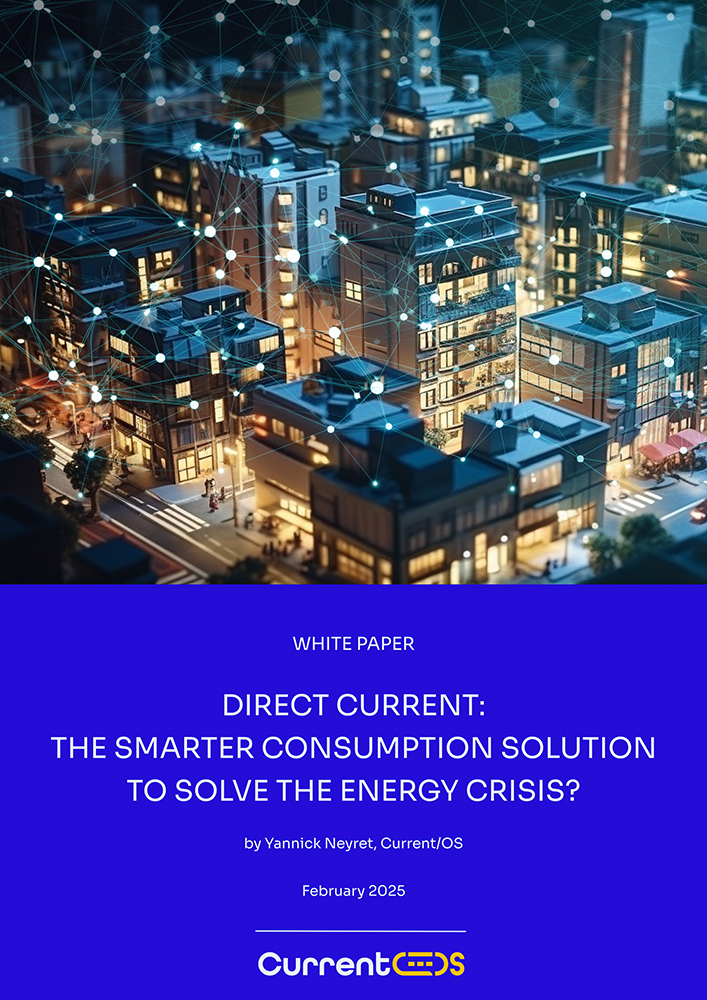
WHITE PAPER
What is Missing in the Rush to an All-Electric Society
Explore why hybrid AC/DC microgrids are emerging as the future of energy systems, offering a compelling solution to relieve grid congestion, ensure grid stability through enhanced control capabilities, and enable advanced features with DC products.
WHITE PAPER
Executive Summary
The energy landscape is undergoing a profound transformation, driven by the increasing demands of an all-electric society and the rise of renewable and decentralized power generation. This shift has created a significant supply-demand crunch, calling for a new technological paradigm. While Alternating Current (AC) has historically shaped our electrical grid, Direct Current (DC) now dominates usage and is rapidly gaining ground in power generation. Hybrid AC/DC microgrids are emerging as the future of energy systems, offering a compelling solution to relieve grid congestion, ensure grid stability through enhanced control capabilities, and enable advanced features with DC products.
This is where Current/OS—a nonprofit, open partnership of electricity stakeholders and manufacturers—comes in. Current/OS is defining a distribution standard for DC to implement self-regulating, resilient power systems for buildings and installations. By fostering collaboration on DC projects within its extensive partner ecosystem, Current/OS is unlocking the full potential of DC technology, promoting interoperability, safety and simplicity in the deployment of DC microgrids and DC products.
Table of Content
- We live in a DC World with an AC Architecture
- Renewables are Accelerating the Shift Towards DC power Generation
- Exploring the Benefits of DC Installations
- Our Challenge: Alleviating Grid Congestion and Ensuring Stability
- The Differing Control Capabilites of AC and DC
- Current/OS Installations: Resolving the Supply and Demand Crunch
About the Author
Yannick Neyret’s unconventional path as a researcher-turned-intrapreneur has always driven him to push innovation forward in response to the societal challenges of electricity distribution. Now President of Current/OS and an European expert in direct current networks, this Supélec graduate has turned each of his roles within the Schneider Electric group into opportunities to explore new fields, leading him to file or co-file around fifteen patents. During the 2000s, he foresaw that electricity distribution would be the hidden challenge of the energy transition. His key focus areas are digitization, automation, and network decongestion, ensuring that everyone has access to reliable, continuous, and sustainable electricity.
About Current/OS
Current/OS is a nonprofit, open partnership of electricity stakeholders and manufacturers committed to researching and developing Direct Current (DC) power distribution for buildings and commercial installations. Our mission is to empower a sustainable future with reliable electricity access for all.
Current/OS is defining the standards for Direct Current Microgrids, to ensure reliable and sustainable DC distribution, operating in a hybrid approach alongside AC from the main grids.
WHITE PAPER
Read Chapter 1
The landscape of power generation and consumption is undergoing a rapid transformation.
On one hand, technological advancements and the increasing electrification of various sectors to support the energy transition are driving a significant rise in electricity demand.
In 2015, electricity accounted for 18% of final energy consumption. By 2023, this share is estimated to have reached 20%. However, to meet global decarbonization targets, the rate of electrification must accelerate significantly. According to the IEA’s (International Energy Agency) Net Zero Emissions by 2050 Scenario—a pathway aligned with limiting global warming to 1.5°C—electricity’s share in final energy consumption needs to approach 30% by 2030, and 60% by 2050.
This must occur in a context wherein the adoption of renewable energy sources and the shift toward decentralized production—where energy is generated closer to the point of consumption, reducing reliance on traditional, centralized power plants—is fundamentally reshaping the power supply.
The pressing urgency of the energy transition away from fossil fuels and the rise of an all-electric society expose a critical imbalance: electricity demand is escalating, while distribution networks are expanding at a much slower pace, unable to keep up. As Eurelectric aptly states, “Connection requests are increasing faster than grid modernisation”3, a concern that is now frequently echoed in the international press.
For instance, the number of electric cars is rapidly outnumbering power capacity forecasts. “By 2030, EVs will represent more than 60% of vehicles sold globally, and require an adequate surge in chargers installed in buildings.”, notes the IEA. On average, EVs consume about 0.2 to 0.3 kWh per kilometer, with peak charging times posing additional strain on the grid.
While many countries have set ambitious targets to phase out internal combustion engine vehicles, they invest in new grid infrastructure and time-of-use pricing strategies. However, these approaches alone may fall short: “Failure to achieve massive amounts of additional grid capacity [with new and modernized infrastructure] would jeopardize 74% of prospective connections in key decarbonization technologies such as electric vehicles (EVs), heat pumps and renewables” writes Eurelectric.
We are not just going through an energy crisis. We are experiencing a supply and demand crunch. A new technological paradigm is therefore essential to meet the growing electricity demand. This challenge goes beyond environmental and economic considerations, carrying significant social implications as reliable access to electricity must be ensured for everyone. In its report “Electricity for the 21st Century”, the International Electrotechnical Commission (IEC) states, “Direct Current is a disruptive technology that fundamentally accelerates energy access and improves energy efficiency.”
Energy experts unanimously agree that DC is the critical enabler for a successful energy transition. Indeed, direct current (DC) has the potential to revolutionize our energy systems and consumption patterns. By enabling smart power management at the level of a building or an installation, it is possible to decrease the demand for feed-in power capacity from the public grid by 2 to 5 times, without impacting the quality of life of the building’s users.
Interested in Current/OS solution? Become a Partner.